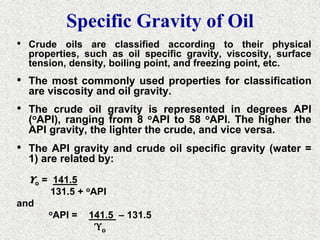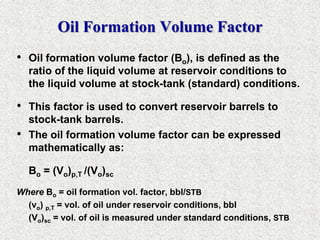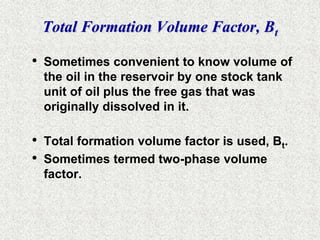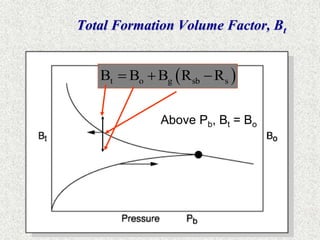OIL PROPERTIES.pdf
- 1. Oil Properties EG314 Reservoir Rocks & Fluid Properties
- 2. Specific Gravity of Oil âĒ Crude oils are classified according to their physical properties, such as oil specific gravity, viscosity, surface tension, density, boiling point, and freezing point, etc. âĒ The most commonly used properties for classification are viscosity and oil gravity. âĒ The crude oil gravity is represented in degrees API (oAPI), ranging from 8 oAPI to 58 oAPI. The higher the API gravity, the lighter the crude, and vice versa. âĒ The API gravity and crude oil specific gravity (water = 1) are related by: ðžo = 141.5 131.5 + oAPI and oAPI = 141.5 â 131.5 Îo
- 3. Bubble Point Pressure âĒ Bubble point as defined by Standing is the state at which an infinitesimal quantity of gas is in equilibrium with a large quantity of fluid. âĒ Bubble point pressure, symbol pb, is the fluid pressure in a system at its bubble point (saturation pressure?) âĒ When the pressure is above the bubblepoint pressure (undersaturated), the fluid is capable of holding additional gases or liquid at the existing pressure and temperature. âĒ When oil & gas are produced and the reservoir pressure drops below the bubble point pressure, gas is liberated from oil. âĒ The following equation is used to estimate the bubble point pressure: pb = 18.2 {[Rs/Îg]0.83 x 10 [0.00091(TR) â 0.0125(oAPI)] - 1.4} Where Rs is the produced gas/oil ratio in SCF/STB and TR is the reservoir temperature in oF.
- 4. Above bubble point pressure. Oil is undersaturated Solution GOR is constant At and below bubble point pressure two phases produced in the reservoir as gas comes out of solution. Solution GOR reduces Solution Gas-Oil Ratio, Rs
- 5. Reservoir Fluid Study âĒ Below bubble point gas released and mobility effected by relative permeability considerations. âĒ Gas separation in the production tubing is different and considered to remain with associated oil. âĒ Two basic liberation mechanisms. Flash liberation Differential liberation
- 6. Reservoir Fluid Study âĒ Flash Liberation (vaporization) The gas is evolved during a definite reduction in pressure and the gas is kept in contact with the liquid until equilibrium has been established. âĒ Differential Liberation (vaporization) The gas being evolved is being continuously removed from contact with the liquid and the liquid is in equilibrium with the gas being evolved over a finite pressure range.
- 7. Above bubble point All gas in solution At bubble point All gas in solution Below bubble point Free gas and solution gas At surface conditions No gas in solution Solution Gas-Oil Ratio, Rs
- 8. Oil Formation Volume Factor âĒ Oil formation volume factor (Bo), is defined as the ratio of the liquid volume at reservoir conditions to the liquid volume at stock-tank (standard) conditions. âĒ This factor is used to convert reservoir barrels to stock-tank barrels. âĒ The oil formation volume factor can be expressed mathematically as: Bo = (Vo)p,T /(Vo)sc Where Bo = oil formation vol. factor, bbl/STB (vo) p,T = vol. of oil under reservoir conditions, bbl (Vo)sc = vol. of oil is measured under standard conditions, STB
- 9. Total Formation Volume Factor, Bt âĒ Sometimes convenient to know volume of the oil in the reservoir by one stock tank unit of oil plus the free gas that was originally dissolved in it. âĒ Total formation volume factor is used, Bt. âĒ Sometimes termed two-phase volume factor.
- 10. Total Formation Volume Factor, Bt ïąThe total formation volume factor is the volume in barrels (cubic metre ) that 1.0 stock tank barrel ( cubic metre ) and its initial complement of dissolved gas occupies at reservoir temperature and pressure conditions. ïĻ ïĐ t o g sb s B B B R R ï― ïŦ ï Rsb = the solution gas to oil ratio at the bubble point.
- 11. Total Formation Volume Factor, Bt Sometimes used in the material balance equation Does not have volume significance in the reservoir. ïĻ ïĐ t o g sb s B B B R R ï― ïŦ ï OIL Hg P = Pb Bob OIL Hg GAS P < Pb Bo Bg(Rsb-Rs) Bt
- 12. Total Formation Volume Factor, Bt ïĻ ïĐ t o g sb s B B B R R ï― ïŦ ï Above Pb, Bt = Bo
- 13. Oil Compressibility âĒ Volume changes of oil above the bubble point are very significant in recovering undersaturated oil. âĒ Oil formation volume factor reflects these changes âĒ More fundamentally in the coefficient of compressibility of the oil. âĒ or oil compressibility Pb o T 1 V c V P ïķ ïĶ ïķ ï― ï ï§ ï· ïķ ïĻ ïļ o o T o B 1 c B P ïķ ïĶ ïķ ï― ï ï§ ï· ïķ ïĻ ïļ In terms of Bo Assuming compressibility does not change with pressure, between conditions 1 & 2. ïĻ ïĐ 2 o 2 1 1 V c P P ln V ï ï― ï



![Bubble Point Pressure
âĒ Bubble point as defined by Standing is the state at which an
infinitesimal quantity of gas is in equilibrium with a large quantity
of fluid.
âĒ Bubble point pressure, symbol pb, is the fluid pressure in a system
at its bubble point (saturation pressure?)
âĒ When the pressure is above the bubblepoint pressure
(undersaturated), the fluid is capable of holding additional gases
or liquid at the existing pressure and temperature.
âĒ When oil & gas are produced and the reservoir pressure drops
below the bubble point pressure, gas is liberated from oil.
âĒ The following equation is used to estimate the bubble point
pressure:
pb = 18.2 {[Rs/Îg]0.83 x 10 [0.00091(TR) â 0.0125(oAPI)] - 1.4}
Where Rs is the produced gas/oil ratio in SCF/STB and TR is the
reservoir temperature in oF.](https://image.slidesharecdn.com/oilproperties-230510043830-a2551bf7/85/OIL-PROPERTIES-pdf-3-320.jpg)









